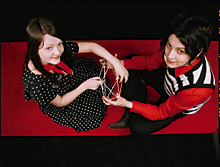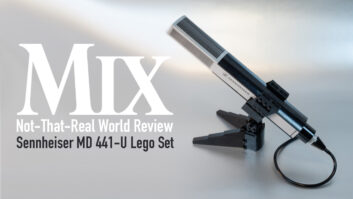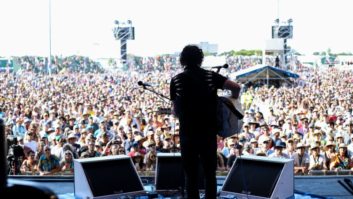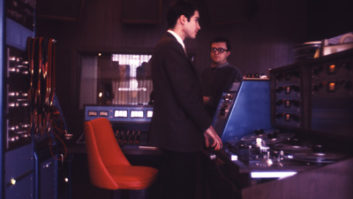
The White Stripes’ brother and sister team, Meg and Jack White, demonstrate Cat’s Cradle.
Working with two musicians and 16 analog tracks sounded like heaven to engineer/producer Joe Chiccarelli when he first got the call to work on the White Stripes’ latest offering, Icky Thump. But he forgot about one thing.
“We’re so used to these pumped-up albums that are big sounding and punchy that when you hear just two instruments au naturale, it doesn’t sound like enough,” he says. “I thought I could take a simple approach at first, that I could make it sound real and big and gorgeous and all that. But you have to work hard to fill up the space, not in a way that it sounds congested or over-produced, but in a way that it sounds full and complete.”
The White Stripes — Jack and Meg White — have made a name for themselves thanks to their interesting blend of blues and rock with alternative music energy. The duo, with Jack White on guitar and vocals and Meg White on drums, met up with Chiccarelli at Blackbird Studios to record these songs after spending a month or so working on songs at Jack White’s Nashville home.
According to Chiccarelli, the recording dates took two to three weeks. “It went down pretty quickly. Jack likes to record fast. He’s an intuitive, fly-by-the-seat-of-his-pants kind of guy. He trusts his gut and that’s the thing I love about him — there isn’t a whole lot of indecision. That’s the way that I like to work, as well.”
That said, the pair of musicians, Chiccarelli and assistant engineer Lowell Reynolds set up in Blackbird’s Studio D. The room boasts a Trident 80 console, and Chiccarelli used an extensive list of vintage analog outboard gear and, rare in this day and age, a 2-inch tape machine. Tracking in analog helped fill some of the sonics that the band may have been missing. “I felt like we got an extra bump on the bottom end, and there was a warmth to the tracks,” the producer says.

Although the gear was vintage, the attitude was modern. “Jack wanted to do something that had a hand in the classic tone that he loves and that some of his recordings have had, but have a modern edge and punch to it,” Chiccarelli reports. “When we first talked about working on [the release], he said he wanted to do an album that had a lot of Pro Tools-style editing that wasn’t done in Pro Tools. In other words, there was a lot of cutting and pasting without concern for tempo or tone consistency. A lot of it was like, ‘We need a bridge? Okay, here you go. Oh, all the sounds are different? That’s okay.’ That gave a lot of dramatic scene changes to the record.”
The key during the recording process was to make sure that the red light was always on. “In all honesty, the process was so fast and quick that we didn’t really spend a lot of time getting sounds,” Chiccarelli admits. “If I spent 30 seconds on a guitar sound, that was a lot. It was really get the stuff up and go, because when they were feeling it and wanted to go they gotta record. The first day was me experimenting with where to put the drums and how to mike them, but after that it was go.”
A small drum kit was put in one of the room’s seven recording spaces, Jack White’s guitar amps were in another space and a Hammond B3 was in another. It was important to have the guitar amps as isolated as possible. “There’s so much passion in his playing and the way he hits the guitar strings has so much attack that the [Fender] Twin was uncomfortably loud,” Chiccarelli says
The Twin was one of two amps that Jack White used, the other being a rare Silvertone piggyback amp. Chiccarelli used an assortment of ribbon mics on the amps, including an AEA R84, a Royer 121 and a Coles. He would also put a Neumann 67 back in the room for ambient tracks. As far as outboard gear, Neve 1073 preamps and UREI 1176 compressor/limiters were typically used, with a Fairchild compressor also being employed occasionally.
Chiccarelli was careful with the track’s loudness. “I don’t record extra-hot levels to tape,” he explains. “I like to have headroom and the openness, so stuff was not overly distorted to tape. I prefer having the transience left intact, and if I need to overdrive something, I’ll do it with an outboard box.”
In the studio’s main room was a larger drum kit for Meg White and space enough for Jack White to play and sing nearby. There were a number of songs, Chiccarelli points out, where the doors to the iso booths were thrown open and the two played without headphones. “We let all the guitar amps bleed into the drum mics and into the drum room mics because the best performance was when they didn’t hear themselves on headphones and when it was real live and off the floor. Some of the bluesy, big, open songs are like that,” he says. “They don’t use a click, so it’s very much dependent on their feel and their timing together. So them being close to each other and Jack not being isolated off was really important.”
One of the appealing features in Blackbird’s Studio D is its live echo chamber. “It’s one of the better live chambers I’ve ever heard,” Chiccarelli says. “It’s a very dark-sounding chamber, but has a lot of character. I wouldn’t say it’s a classic reverb like a Capitol Records echo, but it has a vibe. We used that on a lot of things, even recording some vocals inside the chamber or standing outside the chamber.”
As far as miking Meg White’s kit, Chiccarelli kept things straight ahead: An AKG D-12 on the kick and a U47 as an overhead run through a Fairchild compressor. It was rare that he miked the snare, but when he did it was a U47 through a Fairchild. When she used a bigger kit, Chiccarelli put a 57 on the snare top and a Sennheiser 441 on the bottom. The toms were not miked, but he used an assortment of mics as overheads and in the room. “I set up a lot of different room mics, maybe eight,” Chiccarelli explains. “Depending on the song, I could go smaller, tighter and punchier, or wide and open. Sometimes, I would use old funky cheap mics as room mics and distort them. Other times, it was a pair of Coles, maybe combined with a pair of 87s far up in the room. We did things with drums like pumping them through the reverb chamber or pumping them through guitar amps.”
While the Stripes sound has its foundation in a guitar and drum combination, there were a handful of songs on Icky Thump that included some new instrument choices. For instance, the title track features a vintage Univox synthesizer that Jack White purchased in New Zealand. The keyboard doesn’t have a direct out like most keyboards; it has a built in speaker, so Chiccarelli put an 87 about five feet away from it. “It had so much personality that you didn’t want to put a mic inches away from it — you really wanted to capture how it sounded in the room.”
A pair of songs — “I’m Slowly Turning Into You” and “You Don’t Know What Love Is (You Just Do as You’re Told)” — show off Jack White’s B3 talents. Chiccarelli miked the B3’s Leslie with a tube U47 on the bottom and a pair of KM84s on top. He also had a U67 in the room to capture some of the organ’s ambience. “Sometimes we took a direct out of the organ and sent that through a guitar amp to get a little more edge and bite,” he adds.
On the song “Prickly Thorn, But Sweetly Worn,” the band added bagpipes, mandolin, thigh slaps and hand percussion to the mix. “Meg did two different bass drum tracks, playing the bass drum with a mallet, and then the tracks switch between sections of the song. It started with a dead-er bass drum, then opened up to an almost parade drum sound,” he explains. “That song was interesting, because after we recorded it we decided that it didn’t sound like it was done [live] in the studio enough. Jack is very keen on it sounding honest and like people in a room playing, so we took the mandolin and vocals and pumped them back through the studio loudspeakers and miked the room [with a C24 stereo mic].”
Getting Jack White’s vocal tracks for these songs went slowly, Chiccarelli reports, but not because of any performance issues. “We spent a lot of time with each song, trying to find the right character,” he says, “whether it was choosing an old ribbon mic or a big condenser, distorting a preamp or overcompressing something or putting it through a guitar amp.”
Most of the vocals were recorded on a RCA 77DX ribbon microphone, but a U47 and an old Altec 633 salt shaker mic were also pressed into service. Processing, depending on the track, included a Telefunken V76 tube preamp, an 1176, an LA-3A, a Fairchild and a Chandler Limited EMI TG2 compressor. “Sometimes the vocal went through a guitar amp, sometimes through a Neve module with a preamp turned all the way up,” he says. “He’s great about working the distortion, knowing how to sing to a certain microphone. He knows how to back way off and come way in when he needs to. The vocal is different on every single song.
“There was no vocal comping,” Chiccarelli continues. “If he didn’t like a line, we’d erase it and redo it. It was totally old school, like you’re down to track 15 and that’s the lead vocal track so make the performance count. A couple of songs were tricky, but he’s really good about diving in and working really hard to get the stuff to be what he wants. He’s fearless and that’s a quality I always look for in an artist.”





